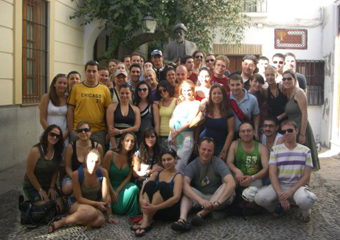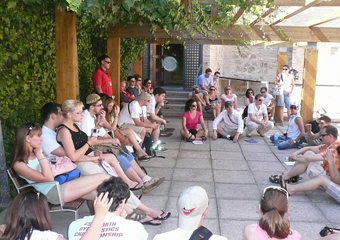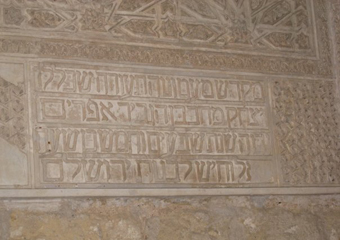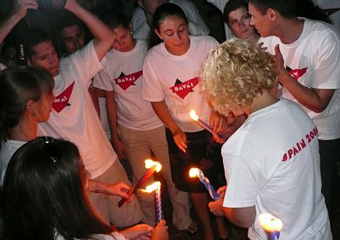Jane in Spain
Permanent link All Posts

Taking a break after an eye-opening discussion about Jewish identity at the statue of the great Jewish philosopher and physician Moises ben Maimon (also known as Maimonides or Rambam) in Cordoba
Seven cities. Seven days. Fifty people. In a nutshell, that’s the recent Jewish heritage adventure in which 36 Russian-speaking Jewish young professionals from Chicago, six peers from Kyiv, Ukraine, and eight staff members explored Spain, Gibraltar and Morocco from Aug. 17 to 25.
The trip is the brainchild of Nadya Strizhevskaya, U.S. project manager for the Genesis Philanthropy Group, which sponsored the adventure as part of its belief that “informed and engaged Russian-speaking Jews will enrich their communities and strengthen the Jewish people.”
“It’s a similar concept to birthright,” Nadya told Olga Shalman and me over dinner one night in February. “It’s about exploring Jewishness through travel.” In the end, as the trip madrichim (Hebrew for group leaders), Olga and I received 60 applications and selected 36 participants with prior leadership and international experience as well as a commitment to create programs for the Russian Jewish community.
Dubbed “Davai!” – Russian for “Let’s Go!” – the trip showed that there’s more to Spain than gilded churches, flamenco and corrida. Jewish history abounds, and this group of Davainiks explored more than just crumbling synagogues and bronze busts throughout the cities we visited. The discussions –on the bus on the way from one historic spot to another or sangria in hand at a late-night café – planted the seed for self-realization.
Day 1
Twelve hours after setting out from Chicago, the group finally arrived in Madrid-Barajas to be whisked to the hotel for a brief rest. Then, it was headfirst into exploring the city. Madrid doesn’t have anything particularly Jewish about it, but the sites are not to be missed. We drove past one of the original city gates, La Puerta de Alcala, past the Prado museum (which we couldn’t get in because museums are closed on Monday), past the Cibeles fountain. We learned about Madrid’s designation as capital in 1561, walked past the Royal Palace and ended up in Plaza Mayor – a cobblestone square that is the center of official life in Madrid.
Then the questions started: How many Jews live in Spain, the number crunchers among us wanted to know. Throughout the entire week, no one could give us an exact number. Turns out, the Spanish government gives tax money to religious organizations in proportion to the number of people officially registered as the religion’s adherents. Spain boasts about 15,000 officially registered Jews, while analysts project a total population of at least 40,000, many of whom are illegal immigrants from North Africa.
Day 2
We left Madrid for Toledo, the ancient fortress that once served as the capital of nascent Spain and remains the seat of the most powerful Catholic Church officials in the country. Until 1492 – the year of the expulsion of Jews and Muslims from Spain – Toledo also had a thriving Jewish population. Though artifacts of that time still remain, today the Jewish population of the city is slim.
Walking into the Transito Synagogue, the first thing visitors encounter is a large stand with the question “What is a synagogue?” However unfamiliar with Judaism our group might have been, we all know the purpose of a synagogue, and this reminder of an entire population who might have never heard about Jews and our houses of worship was a powerful message. The synagogue is an incongruous mixture of styles: The ornamentation is representative of the “Mudejar” style – vines and flowers in faded reds and greens adorn the walls, while the crests of the Spanish kingdoms of Castilla and Leon sit alongside ornate Hebrew inscriptions. As most non-Christian houses of worship, the Toledan synagogues were converted into churches and later restored as museums.

The group studies poetry and Maimonides’ proclamations at the Jewish museum in Toledo
The courtyard of the synagogue museum was the perfect spot for a bit of light reading and our first attempts at hevruta – a method of studying text in pairs where argument reigns supreme. Guided by David Shneer, Associate Professor of Jewish Studies at the University of Colorado at Boulder, who developed the education portion of the trip, the group read Maimonides’ suggestions for the “cures of the diseases of the soul” as an introduction to Jewish identity exploration. We talked about combining different sides of one’s life – like Maimonides, the philosopher and physician who was one of Jewish Spain’s most important figures before being forced to flee to Fez, in modern-day Morocco.
Day 3
Everything Maimonides was the theme of the day in Cordoba, the former capital of the Caliphate of Cordoba. Café Maimonides, hotel Maimonides – you get the picture. The sage once again served as a jumping off point for an open-air discussion of what it means to be Jewish: Russian-Jewish, Jewish-American, Jewish-Ukrainian or a combination of these. The group yearned for just such a discussion as they struggled to balance their Russian heritage and their American education: “What is Jewish?” asks Gene Rapoport, a trip participant. “We all approach Judaism differently – whether from a religious or a cultural perspective. And while Jewishness is open to interpretation, it’s something we all have in common.”
After the spirited discussion, the Mezquita Catedral – the former mosque turned church – galvanized our taste for history. It took 100 years to build the giant space, which houses marble columns, bricks and other building materials from around the Mediterranean. The Mezquita was our last stop before heading to Granada. We climbed the fortress in the Alhambra complex, strolled through the Generalife gardens and took a night-time tour of the Mudejar-style palace, where the city’s rulers used to live. Throughout it all, the group marveled at the beauty of the carved walkways and arches that have survived centuries of war, siege and disuse.

Twelfth-century Hebrew inscriptions were uncovered when the last remaining synagogue in Granada became a museum in the middle of the twentieth century
Day 4
Our journey continued to Sevilla, the largest city in the southern province of Andalucia and the site of the most fervent persecution of Jews in the 15th and 16th Centuries. In fact, the only reminder of a once-thriving Jewish population is a sign for the Juderia (Jewish Quarter) that no longer exists. Our tour guide wondered why we were even seeking the Jewish sites in a city that refurbished the Jewish Quarter into the Holy Cross Quarter and erected a church on the plaza formerly housing a synagogue. Much like visiting run-down shtetls, Sevilla became a powerful reminder of lost generations and the need to explore and preserve Jewishness.
Day 5
In comparison to the 20 Jewish families living in the Sevillian sprawl, the 4,000-strong Gibraltar Jewish community was welcome news. Our Ukrainian participants had minor trouble at the border of the British territory that required a return visit to passport control, but once that was settled the group set out to explore The Rock. We climbed into St. Michael’s Cave, a network of limestone caves where two Neanderthal skulls were discovered. We also played with the Barbary Apes, who roam freely around the Upper Rock Nature Reserve.
But our most exciting moment came with the welcoming of Shabbat. Some participants had experienced Shabbat only as birthright participants or knew only the outlines of the rituals, while others had led prayers before. As testament to the group’s do-Judaism-your-own-way philosophy, our mostly secular group chose to sing parts of the Kabbalat Shabbat service, with some participants leading the prayers as group member and guitarist Vova Kuperman played along. The feeling of togetherness in a Jewish setting made for what one formerly Orthodox participant called “the most meaningful Shabbat experience” of her life.
Day 6
As the traditional day of rest, Shabbat was hardly packed with activity. After a morning hike, most participants lounged on the beach. Havdalah and a closing session brought everyone together for reflections and planning our next ventures. Four women and a man held havdalah candles, bringing the Shabbat light to the entire circle. Performed in the courtyard of the Garrison Library – one of the oldest military archives in Great Britain and the personal home of Admiral Nelson – the Havdalah ritual also marked a moment of meditation on our place in the Jewish community.

A spirited Havdalah provided the perfect closing note to our adventure
In the tradition of birthright and weekend retreats, each participant spoke about what they would take away from our adventure: a deeper commitment to Jewishness, a sense of community, a realization that Judaism takes many forms, new friendships and plans for action at home. As David Shneer put it, participants “are coming away from this trip knowing that Jewish life happens wherever they are.”
Day 7
Having closed one chapter of our trip, we headed to Tangier, Morocco, which seemed like an alternate reality to the tidy, utterly British Gibraltar. Divided into the medinah (old city) and the new, industrialized parts, Tangier leaped at us with ancient cobble-stone streets, street peddlers selling everything from spices to purses to fresh figs, and, predictably a Rue Synagogue (Synagogue Street), which no longer houses any synagogues. Although some Jews do live in Morocco, many have left for Israel, Europe and the States – another potent symbol of the cyclical nature of the Jewish experience.
What’s next?
Our swift journey – the first of its kind for Russian-speaking Jews – barely skimmed the surface of Spain’s Jewish heritage, but the purpose of the trip wasn’t just to learn about history. As a madricha, I like to think that our group came away with a deeper understanding of what it means to be Jewish – however we define Judaism and Jewishness for ourselves. We also came away with plans for reunions, events and programs that could bring other Russian-speaking Jews closer to the Jewish community and make them feel that they belong in the Jewish world.
If you want to participate in upcoming Davai! events or want more information, check out the Davai! page on Facebook.



.jpg)



